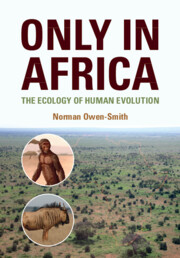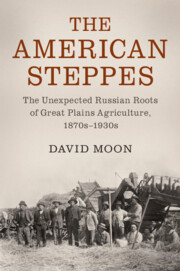Refine search
Actions for selected content:
31 results
10 - Biocultural Landscapes
-
- Book:
- Regulating a Thousand Cuts
- Published online:
- 27 September 2025
- Print publication:
- 09 October 2025, pp 274-309
-
- Chapter
-
- You have access
- Open access
- HTML
- Export citation
Short-term effectiveness of Ulex europaeus control measures in Uruguay
-
- Journal:
- Invasive Plant Science and Management / Volume 18 / 2025
- Published online by Cambridge University Press:
- 19 August 2025, e22
-
- Article
-
- You have access
- Open access
- HTML
- Export citation
Madagascar’s environmental and human histories are dynamic, complex and deeply intertwined
-
- Journal:
- Environmental Conservation / Volume 52 / Issue 3 / September 2025
- Published online by Cambridge University Press:
- 01 July 2025, pp. 94-97
-
- Article
-
- You have access
- HTML
- Export citation
Changes in the soil detrital food chain associated with Gunnera tinctoria plant invasions
-
- Journal:
- Invasive Plant Science and Management / Volume 18 / 2025
- Published online by Cambridge University Press:
- 10 March 2025, e11
-
- Article
-
- You have access
- Open access
- HTML
- Export citation
Old-growth grasslands of Central Anatolia (Türkiye) require better conservation and management
-
- Journal:
- Environmental Conservation / Volume 51 / Issue 4 / December 2024
- Published online by Cambridge University Press:
- 04 December 2024, pp. 242-244
-
- Article
-
- You have access
- HTML
- Export citation
Population status, habitat preference and distribution of Bristled Grassbird Chaetornis striata in Bangladesh
-
- Journal:
- Bird Conservation International / Volume 33 / 2023
- Published online by Cambridge University Press:
- 25 August 2022, e27
-
- Article
-
- You have access
- Open access
- HTML
- Export citation
Chapter 6 - Forms of Savanna: From Woodland to Grassland
- from Part II - The Savanna Garden: Grassy Vegetation and Plant Dynamics
-
- Book:
- Only in Africa
- Published online:
- 09 September 2021
- Print publication:
- 07 October 2021, pp 69-96
-
- Chapter
- Export citation

Only in Africa
- The Ecology of Human Evolution
-
- Published online:
- 09 September 2021
- Print publication:
- 07 October 2021
An assessment of the Important Bird Areas (IBAs) of southern Paraguayan grasslands
-
- Journal:
- Bird Conservation International / Volume 31 / Issue 2 / June 2021
- Published online by Cambridge University Press:
- 20 May 2020, pp. 312-325
-
- Article
- Export citation
Influence of experience, interest, knowledge and learning source on children’s attitudes towards extensive grassland conservation
-
- Journal:
- Environmental Conservation / Volume 47 / Issue 2 / June 2020
- Published online by Cambridge University Press:
- 15 April 2020, pp. 130-137
-
- Article
- Export citation
Phenology and plant functional type dominance drive CO2 exchange in seminatural grasslands in the Pyrenees
-
- Journal:
- The Journal of Agricultural Science / Volume 158 / Issue 1-2 / March 2020
- Published online by Cambridge University Press:
- 01 April 2020, pp. 3-14
-
- Article
-
- You have access
- HTML
- Export citation

The American Steppes
- The Unexpected Russian Roots of Great Plains Agriculture, 1870s–1930s
-
- Published online:
- 23 March 2020
- Print publication:
- 02 April 2020
Chapter Three - Microbiomes of soils
-
-
- Book:
- Microbiomes of Soils, Plants and Animals
- Published online:
- 07 March 2020
- Print publication:
- 12 March 2020, pp 29-54
-
- Chapter
- Export citation
CULTIVATING TORGHUT MONGOLS IN A SEMI-ARID STEPPE
-
- Journal:
- Journal of Chinese History / Volume 2 / Issue 2 / July 2018
- Published online by Cambridge University Press:
- 29 May 2018, pp. 355-372
-
- Article
-
- You have access
- HTML
- Export citation
Evidence of a late glacial warming event and early Holocene cooling in the southern Brazilian coastal highlands
-
- Journal:
- Quaternary Research / Volume 89 / Issue 1 / January 2018
- Published online by Cambridge University Press:
- 24 October 2017, pp. 90-102
-
- Article
- Export citation
Regional Suitability Assessment for the Mouseear Hawkweed (Hieracium pilosella) Invasion in Patagonian Rangelands
-
- Journal:
- Invasive Plant Science and Management / Volume 9 / Issue 4 / December 2016
- Published online by Cambridge University Press:
- 03 April 2017, pp. 242-251
-
- Article
- Export citation
Effect of Biological Control on Leafy Spurge (Euphorbia esula) and Diversity of Associated Grasslands Over 14 Years
-
- Journal:
- Invasive Plant Science and Management / Volume 2 / Issue 2 / April 2009
- Published online by Cambridge University Press:
- 20 January 2017, pp. 151-157
-
- Article
- Export citation
Phytolith evidence for C4-dominated grassland since the early Holocene at Long Pocket, northeast Queensland, Australia
-
- Journal:
- Quaternary Research / Volume 61 / Issue 2 / March 2004
- Published online by Cambridge University Press:
- 20 January 2017, pp. 168-180
-
- Article
- Export citation
Pasture harvest, carbon sequestration and feeding potentials under different grazing intensities
-
- Journal:
- Advances in Animal Biosciences / Volume 6 / Issue 1 / March 2015
- Published online by Cambridge University Press:
- 17 February 2015, pp. 43-45
- Print publication:
- March 2015
-
- Article
- Export citation
